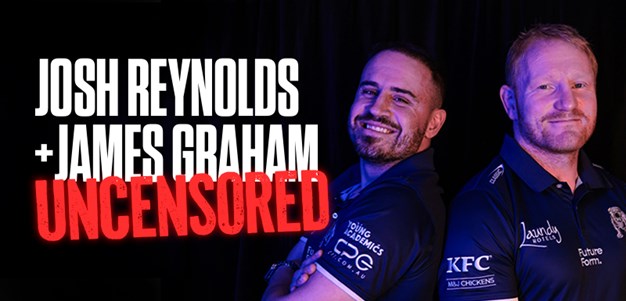

On Saturday night, the 15th iteration of the Rugby League World Cup will come to an end.
From 14 teams in the men's competition and six teams in the women's competition, only four teams remain.
When the Australian Jillaroos take the field to play the Kiwi Ferns, they will play the first game in a double-header later to be followed by the Australian Kangaroos taking on the England men's team.
This will be the first time in the history of any sport that a men's and women's final have been contested on the same day and played on the same field.
But there have been plenty of special moments that have seen us reach this point.
Given how monumental this World Cup has been for the women's game, I thought I would share my favourite moment featuring each of the six women's teams that have competed.
Canada Ravens
For many women selected in the Canada Ravens squad, this was their first opportunity to play rugby league. With a team made up mainly of rugby union and rugby sevens players, the team performed admirably, ultimately being knocked out of the tournament in the semi-finals by the Jillaroos, 58-6.
But the results don't matter as much as the headlines and interest that the Ravens have generated back home for women's rugby league.
My favourite moment for this squad was when Canadian Prime Minister Justin Trudeau wrote the squad a letter offering his congratulations for their participation in the World Cup.
Prime Minister Trudeau said it best when he said, "You should be very proud in what you bring to this level of competition, and you can take great pride in the talents you have worked so hard to develop". That talent was certainly on show when the Ravens recorded their first ever win in international rugby league against Papua New Guinea.
My hope is that that win will be the first of many.
Papua New Guinea Orchids
For me, the moment of the tournament for the Orchids came before they even took the field at Southern Cross Group Stadium.
PNG is a dangerous place to live if you are female. The majority of women in PNG have either experienced sexual assault, rape or extreme violence. The majority. I still struggle to get my mind around that.
Rugby league can play a role in changing this and demonstrating that women can be strong, physical and confident and that women can be part of the rugby league family – a game which, as PNGs national sport, has tremendous significance.
That change is already happening.
Before the Orchids left PNG for Australia, the team was given the opportunity to take the field at half-time during the game between the United States Rugby League team and the PNG Kumuls.
In the not too distant past, women were not allowed onto the turf at the stadium. They would have been physically assaulted and people would have thrown rocks at them.
But on this day, the stadium erupted in cheers for the Orchids, Papua New Guinea's newest national heroes.
It's important for rugby league officials in PNG to keep this momentum going so that women are not only welcome in stadiums but are welcome there to watch both men and women compete.
Kiwi Ferns
I don't just have one moment for the Kiwi Ferns. I have several. And more specifically, every moment involving Honey Hireme.
What a player!
Honey has scored the most points in the competition with 44. She has also scored the most tries in the competition with 11, well ahead of Karina Brown from the Jillaroos who has scored six.
The Jillaroos may have had more consistent players across the board (making it harder to pick just one stand-out player), but Honey has certainly been the stand out for the Ferns.
The key to an Australian victory on Saturday night: shutting her down.
England Lionesses
It was a tough old tournament for the Lionesses who were defeated by the Kiwi Ferns 52-4 in the semi-finals.
Despite a tough tournament though it was clear that England are the third best women's rugby league team in the world. They scored 56 points (ranked only below Australia and New Zealand) and made the most tackles in the tournament with 1108.
But to remain number three, ahead of nations like Canada and the Cook Islands, England will need to ensure that they remain committed to women in rugby league over the years ahead. If they don't, the risk is that they will fall behind.
Cook Islands
The moment for the Cook Islands was their shock victory over England 22-6.
I've watched the match-winning try over and over on repeat. The offload from Kura Ngata-Aerengamata to her sister Te Amohaere Ngata-Aerengamata to seal the win, and then the celebrations from the team like they had just won the World Cup Final.
What's scary (in a positive way) is how much potential this Cook Islands team has. Some of the women playing in that team had never played rugby league before. The team only came together the week the tournament started. Look what they were able to achieve.
Can you imagine how good this team could be in four years' time, given the opportunity?
Australian Jillaroos
Might I be so bold as to suggest that the Jillaroos moment has not come yet – it will come on Saturday night when they defeat the Kiwi Ferns and are crowned Rugby League World Cup champions.
That would not only be the perfect end to a tremendous tournament, but it would cap off a momentous year for women who play rugby league.
2017 was a year which saw the Jillaroos defeat the Ferns on every occasion they met. It was a year where a joint partnership between Harvey Norman and NSWRL and QRL was announced meaning that there is now an unbroken pathway from age six to opens for women to play rugby league and a year where Ruan Sims, Kezie Apps, Maddie Studdon and Sammy Bremner became household names.
Whatever the result the future looks bright for women playing rugby league.
Good luck to both teams competing tomorrow night, but most importantly, good luck to the Jillaroos. This trophy belongs to you.







